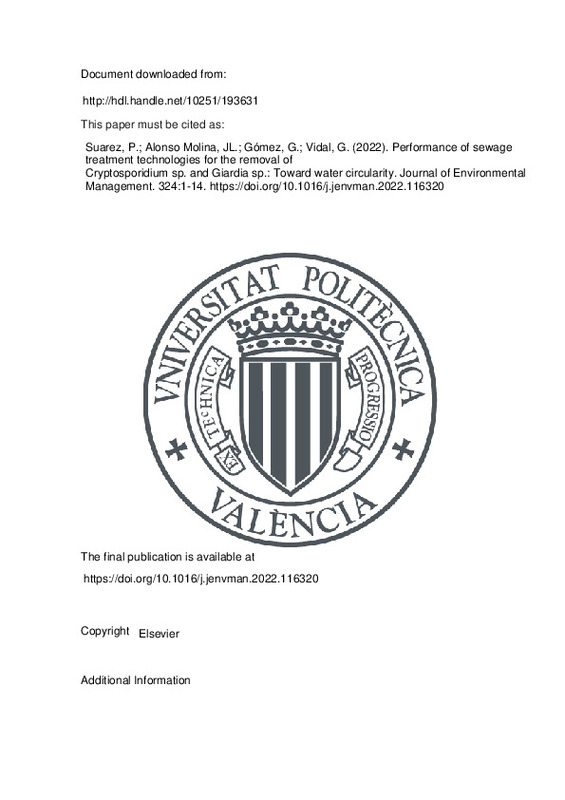JavaScript is disabled for your browser. Some features of this site may not work without it.
Buscar en RiuNet
Listar
Mi cuenta
Estadísticas
Ayuda RiuNet
Admin. UPV
Performance of sewage treatment technologies for the removal of Cryptosporidium sp. and Giardia sp.: Toward water circularity
Mostrar el registro sencillo del ítem
Ficheros en el ítem
| dc.contributor.author | Suarez, Pilar
|
es_ES |
| dc.contributor.author | Alonso Molina, José Luís
|
es_ES |
| dc.contributor.author | Gómez, Gloria
|
es_ES |
| dc.contributor.author | Vidal, Gladys
|
es_ES |
| dc.date.accessioned | 2023-05-26T18:01:47Z | |
| dc.date.available | 2023-05-26T18:01:47Z | |
| dc.date.issued | 2022-12-15 | es_ES |
| dc.identifier.issn | 0301-4797 | es_ES |
| dc.identifier.uri | http://hdl.handle.net/10251/193631 | |
| dc.description.abstract | [EN] Cryptosporidium sp. and Giardia sp. are parasites that cause diseases in the population. Most of parasite diseases regarding the consumption of drinking water polluted with sewage are caused by Cryptosporidium sp. or Giardia sp. it is because of the incomplete disinfection of the wastewater treatment. Therefore, in this work the removal or inactivation efficiency of different treatment technologies presented by around 40 scientific studies was evaluated, with a view to water circularity. For Cryptosporidium sp., we conclude that the most efficient sec- ondary technologies are aerobic technologies, which remove between 0.00 and 2.17 log units (Ulog), with activated sludge presenting the greatest efficiency, and that the tertiary technologies with the greatest removal are those that use ultrasound, which reach removal values of 3.17 Ulog. In the case of Giardia sp., the secondary technologies with the greatest removal are anaerobic technologies, with values between 0.00 and 3.80 Ulog, and the tertiary technologies with the greatest removal are those that combine filtration with UV or a chemical disinfection agent. Despite the removal values obtained, the greatest concern remains detecting and quantifying the infectious forms of both parasites in effluents; therefore, although the technologies perform adequately, discharge effluents must be monitored with more sensitive techniques, above all aiming for circularity of the treated water in a context of the water scarcity that affects some parts of the world. | es_ES |
| dc.description.sponsorship | This work was supported by ANID/FONDAP/15130015. P. Suarez thanks to ANID/Scholarship Program/DOCTORADO BECAS CHILE/2021-21210338 for her scholarship. | es_ES |
| dc.language | Inglés | es_ES |
| dc.publisher | Elsevier | es_ES |
| dc.relation.ispartof | Journal of Environmental Management | es_ES |
| dc.rights | Reconocimiento - No comercial - Sin obra derivada (by-nc-nd) | es_ES |
| dc.subject | Sewage treatment | es_ES |
| dc.subject | Cryptosporidium | es_ES |
| dc.subject | Giardia | es_ES |
| dc.subject | Sewage | es_ES |
| dc.subject | Disinfection | es_ES |
| dc.subject | Water reuse | es_ES |
| dc.title | Performance of sewage treatment technologies for the removal of Cryptosporidium sp. and Giardia sp.: Toward water circularity | es_ES |
| dc.type | Artículo | es_ES |
| dc.identifier.doi | 10.1016/j.jenvman.2022.116320 | es_ES |
| dc.relation.projectID | info:eu-repo/grantAgreement/ANID//ANID%2FFONDAP%2F15130015/ | es_ES |
| dc.relation.projectID | info:eu-repo/grantAgreement/ANID//2021-21210338/ | es_ES |
| dc.rights.accessRights | Abierto | es_ES |
| dc.contributor.affiliation | Universitat Politècnica de València. Instituto Universitario de Ingeniería del Agua y del Medio Ambiente - Institut Universitari d'Enginyeria de l'Aigua i Medi Ambient | es_ES |
| dc.description.bibliographicCitation | Suarez, P.; Alonso Molina, JL.; Gómez, G.; Vidal, G. (2022). Performance of sewage treatment technologies for the removal of Cryptosporidium sp. and Giardia sp.: Toward water circularity. Journal of Environmental Management. 324:1-14. https://doi.org/10.1016/j.jenvman.2022.116320 | es_ES |
| dc.description.accrualMethod | S | es_ES |
| dc.relation.publisherversion | https://doi.org/10.1016/j.jenvman.2022.116320 | es_ES |
| dc.description.upvformatpinicio | 1 | es_ES |
| dc.description.upvformatpfin | 14 | es_ES |
| dc.type.version | info:eu-repo/semantics/publishedVersion | es_ES |
| dc.description.volume | 324 | es_ES |
| dc.identifier.pmid | 35217446 | es_ES |
| dc.relation.pasarela | S\481519 | es_ES |
| dc.contributor.funder | Agencia Nacional de Investigación y Desarrollo de Chile | es_ES |







![[Cerrado]](/themes/UPV/images/candado.png)

